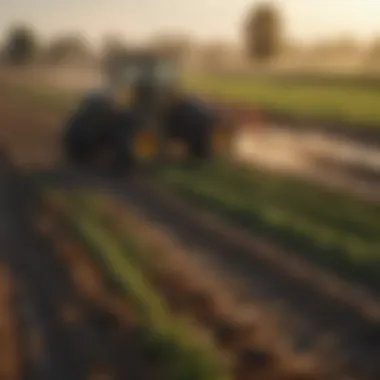Utilizing RPA for Risk Management in Agriculture


Intro
The agricultural sector is undergoing significant transformation as it embraces technology to address various challenges. One such advancement is Robotic Process Automation (RPA), which is reshaping risk management in farming. By automating routine processes, these technologies enhance efficiency and reduce errors, allowing farmers to focus on more complex decision-making tasks. This article will explore the types of risks prevalent in agriculture and how RPA solutions can directly mitigate these risks, thus fostering greater sustainability and productivity in farming practices.
Latest Trends in Agriculture
Overview of Current Trends
Agriculture is witnessing dynamic changes influenced by both market demands and technological advancements. Farmers are increasingly turning to data-driven approaches that allow them to make informed decisions. Trends include precision agriculture, where satellite imagery and IoT sensors provide valuable insights into crop health and soil conditions. Additionally, there is a growing interest in vertical farming, which maximizes space usage and minimizes resource consumption.
Impact of Technology on Farming Practices
The role of technology in modern agriculture cannot be overstated. Automation, including RPA, is transforming how farms operate. For instance, automated irrigation systems optimize water usage, while drones monitor crop growth and detect pests. As a result, farmers are capable of reducing operational costs and enhancing yields. This alignment of technology with agricultural needs supports better risk management, turning potential threats into controllable variables.
Sustainable Practices: Towards a Greener Future
Importance of Sustainability in Agriculture
Sustainability is a pressing concern for contemporary agriculture. With climate change and resource depletion, practices must adapt to ensure long-term viability. Sustainable agriculture aims to maintain ecosystem balance while satisfying food demands. This approach also addresses environmental concerns by promoting biodiversity and soil health.
Methods for Sustainable Farming
Implementing sustainable methods is essential for reducing risks associated with farming. Farmers can adopt strategies such as crop rotation, agri-environmental schemes, and organic farming. RPA can facilitate these methods by automating data collection and analysis. This leads to better track record on crop performance, inputs used, and overall environmental impact.
Gardening Techniques and Tips
Essential Gardening Tools and Equipment
For effective gardening, having the right tools is vital. Essential equipment includes:
- Hand trowels for digging
- Pruning shears for maintaining plant health
- Soil testers to assess nutrient levels
- Watering cans or hoses for efficient irrigation
Using RPA technologies can help manage tool inventories as well as scheduling maintenance tasks. This allows for smoother operation and less downtime due to malfunctioning equipment.
Seasonal Gardening Practices
Understanding seasonal practices helps in planning and executing effective gardening strategies. Monitoring weather patterns and soil conditions is crucial for success. RPA can automate this monitoring, providing farmers with timely updates on optimal planting and harvesting times, minimizing the risks related to crop management.
"Adopting automated solutions not only enhances operational efficiency but also significantly mitigates potential risks in agriculture."
Through the insights discussed, this article outlines how RPA acts as a catalyst in revolutionizing risk management within agriculture, thereby enabling farmers to pursue both productivity and sustainability.
Understanding RPA and Its Relevance in Agriculture
Robotic Process Automation (RPA) is becoming increasingly significant in the agriculture sector. As farmers and agricultural professionals face numerous challenges, RPA offers solutions that can streamline processes, enhance productivity, and mitigate risks. This section will elucidate the key aspects of RPA in agriculture, covering its definition, technological evolution, and importance in everyday practices.
Definition of Robotic Process Automation


Robotic Process Automation refers to technology that allows software robots to perform repetitive tasks usually done by humans. These tasks include data entry, information retrieval, and various administrative duties. By automating these mundane tasks, farmers can allocate their time and resources to more strategic activities that enhance productivity and yield. RPA integrates seamlessly with existing systems, making it a flexible choice for agribusinesses looking to improve efficiency without overhauling their entire IT infrastructure.
Evolution of RPA Technologies
The evolution of RPA technologies has paralleled advancements in computing and data management. Initially, automation was limited to simple rule-based systems, but with the development of Artificial Intelligence and machine learning, RPA has transformed in its effectiveness. Modern RPA solutions can now analyze large data sets, learn from them, and make decisions based on analytical insights. This capacity for self-learning allows for more sophisticated risk management strategies in agriculture. Companies such as UiPath and Blue Prism are at the forefront of these advancements, continuously integrating new capabilities into their platforms.
Importance of RPA in Agricultural Practices
The importance of RPA in agriculture cannot be overstated. This technology helps reduce operational costs, minimize errors, and streamline workflows. Here are some key benefits of RPA in agricultural practices:
- Efficiency: Automating repetitive tasks allows farmers to focus on more strategic issues, improving overall farm management.
- Data Accuracy: Robots process data with a high degree of precision, reducing the likelihood of human error.
- Scalability: RPA can easily scale operations, accommodating growing demands without a proportional increase in labor costs.
- Compliance: RPA can also assist in maintaining regulatory compliance by automating data collection and reporting processes.
In summary, as the agricultural sector continues to evolve, adopting technologies like RPA becomes crucial for staying competitive. It empowers farmers to handle risks more effectively and promotes sustainable farming practices.
RPA has the potential not only to enhance productivity but also to reshape the agricultural landscape, making it more resilient against various challenges.
By understanding these foundational elements of RPA, agricultural professionals can better appreciate its relevance and potential impact on risk management in agriculture.
Identifying Risks in Agriculture
Identifying risks in agriculture is crucial for effective management and overall sustainability in farming practices. Understanding these risks enables farmers to devise strategies that minimize potential losses and maximize productivity. The agricultural sector is inherently risky due to its dependence on unpredictable environmental factors, market fluctuations, and evolving regulations. Therefore, farmers must continuously assess their risk landscape to develop informed responses that not only protect their assets but also enhance their operational efficiencies.
Types of Risks Faced by Farmers
Farmers encounter various types of risks that can affect their operations and profitability. Understanding these risks helps in strategizing for efficiency and long-term success.
Financial Risks
Financial risks encompass factors that may lead to losses in a farmer's profitability. This includes various elements such as credit risk, investment risk, and uncertainties related to obtaining financing. Financial risk is significant because it directly affects a farmer's ability to sustain operations. A unique feature of financial risks is their direct correlation with market conditions, interest rates, and commodity prices. This can lead to either favorable outcomes or severe setbacks depending on market dynamics. In this discussion, recognizing financial risks is not just beneficial but essential for informed decision-making and financial planning.
Operational Risks
Operational risks relate to internal processes that may fail or be disrupted. This includes machinery malfunctions, workforce issues, or procedural errors. Operational risk is notable because it directly impacts day-to-day farming activities. One unique aspect of operational risks is that they can be mitigated by establishing effective standard operating procedures and training programs. These measures can reduce the chances of disruptions and improve overall productivity in the agricultural setting. Understanding operational risks helps in safeguarding the effectiveness of farming operations.
Environmental Risks
Environmental risks involve external factors such as adverse weather conditions, pests, and diseases that can negatively influence crop yields. These risks are critical due to their unpredictability and potential severity. A key characteristic of environmental risks is that they are often beyond the farmer's control. The unique feature of environmental risks lies in their ability to affect not only current but also future farming seasons. Effective risk management strategies for environmental risks are vital to sustaining long-term agricultural success.
Market Risks
Market risks emerge from changes in supply and demand dynamics, pricing fluctuations, and shifts in consumer preferences. This category of risk can significantly impact a farmer's revenue and viability. The defining characteristic of market risks is their direct influence on sales and profitability. An advantage of understanding market risks is the ability for farmers to adjust strategies, such as diversifying crops or exploring new markets, to counteract potential impacts. Market risks, while challenging, offer opportunities for innovation in marketing and product development.
Impact of Risks on Agricultural Productivity
The impact of risks significantly affects agricultural productivity. High-risk exposure can lead to inconsistent yields and financial stress, while well-managed risks can enhance productivity through informed decisions. Higher productivity can be achieved by identifying risks early and employing effective management strategies. Recognizing how risks play a role in productivity can lead to greater innovations in farming practices.
Case Studies: Historical Instances of Risk


Analyzing historical instances of risks faced in agriculture can provide valuable lessons for today's farmers. By examining cases where risks were poorly managed, it is possible to derive insights on best practices for risk mitigation. These real-life examples serve as a crucial learning tool, illustrating the importance of proactive risk management strategies in achieving agricultural sustainability.
The Role of RPA in Risk Management
Robotic Process Automation (RPA) is gaining significance in agriculture, especially concerning risk management. The agricultural landscape is inherently fraught with uncertainties, and leveraging RPA can enhance the way farmers identify, assess, and mitigate risks. This section outlines specific RPA applications tailored for effective risk mitigation, emphasizing their importance in the agricultural sector.
RPA Applications in Risk Mitigation
Data Collection and Analysis
Data collection is pivotal in identifying potential risks in agriculture. RPA tools assist in gathering vast amounts of data from various sources, such as weather patterns, crop yields, and market fluctuations. By automating these processes, farmers can ensure timely and accurate data collection.
One key characteristic of RPA in data collection is scalability. With RPA, farmers can easily scale their data operations as needed. This is increasingly essential in today’s agri-business environments where decisions must be data-driven. RPA allows for the rapid processing of data, which can significantly enhance forecasting capabilities.
A unique feature of automated data analysis is its ability to reduce human error. In agriculture, even minor inaccuracies in data can lead to substantial financial losses or crop failures. However, while the advantages are many, farmers should consider the initial costs and integration time of RPA technology as potential disadvantages in implementing these solutions.
Automating Compliance Monitoring
Compliance is critical in agriculture, where regulations often change. With RPA, monitoring and ensuring adherence to compliance standards becomes much more efficient. The automation of these processes aids in minimizing the risks associated with non-compliance, which can lead to penalties or operational setbacks.
The key characteristic of RPA in compliance monitoring lies in its ability to constantly monitor regulations and apply necessary updates. This dynamic approach provides peace of mind to farmers. It helps avoid potential violations that might not be immediately apparent.
The unique benefit of automating compliance tasks is the reduction in labor costs, allowing staff to focus on more strategic activities. However, the challenge can lie in ensuring that the RPA systems are updated correctly and aligned with local regulations, which can vary significantly.
Enhancing Supply Chain Management
Supply chain management is another area where RPA proves itself beneficial. Agriculture often involves intricate supply chains that are sensitive to various disruptions, such as weather changes or market demand shifts. RPA tools help in streamlining these supply chains by automating processes from order placement to delivery.
A noticeable characteristic of RPA in this realm is real-time tracking. With automation, stakeholders have a clearer view of supply chain dynamics, allowing for quick adjustments in response to unexpected events. This visibility can greatly enhance decision-making processes, enabling quicker response to potential risks.
However, like other RPA aspects, integrating these solutions requires a thorough assessment of existing processes. While many advantages exist, such as improved efficiency and reduced operational costs, possible challenges may stem from the complexity of adapting current systems to new RPA technologies.
Benefits of Integrating RPA in Agriculture
Integrating RPA into agricultural practices can lead to increased operational efficiency. It can also support data-driven decision-making, ultimately enhancing productivity. The ability to automate repetitive tasks frees up valuable time for farmers to focus on strategy and innovation. Moreover, as farming techniques become more complex, RPA provides the necessary tools to manage this complexity.
Challenges in Implementing RPA Solutions
Despite the benefits, implementing RPA solutions poses several challenges. Farmers must consider the initial investment and the learning curve associated with new technologies. Additionally, the integration of RPA with existing systems can require significant effort. Therefore, careful planning and gradual implementation are essential to reap the full advantages of RPA.
"RPA offers a profound opportunity for farmers to rethink how they manage risks, ultimately leading to more sustainable practices."
Best Practices for Implementing RPA in Agriculture
Implementing Robotic Process Automation (RPA) in agriculture comes with distinct advantages, but care must be taken to ensure successful integration. Best practices can guide professionals in optimizing RPA systems, fostering not only efficiency but also sustainability in farming operations. Following these practices can help alleviate common challenges and create pathways to successful implementation.
Assessing Organizational Readiness


Before embarking on an RPA journey, it is crucial to assess organizational readiness. This includes evaluating existing processes, infrastructure, and the culture within the organization. It is necessary to determine whether current workflows can support automation and if there is a willingness to adopt new technologies. In addition to evaluating technical aspects, the human factor is vital. Employees must be open to changes and willing to learn how to work alongside robotic systems. Organizations should consider the following aspects:
- Current Technology: Does the existing tech stack support new RPA tools?
- Workforce Skills: Are employees equipped with the necessary skills to adapt to automation?
- Management Support: Is there clear buy-in from leadership for RPA implementation?
By systematically assessing these areas, farms can ensure a smoother transition to automated processes while minimizing resistance from staff.
Selecting Appropriate RPA Tools
Choosing the right tools is fundamental for successful RPA deployment. There are numerous software options available, and understanding specific needs of the agricultural operation is vital in making informed choices. Factors to consider include:
- Functionality: Tools should align well with the tasks they are intended to automate, such as data analysis or supply chain management.
- Scalability: RPA solutions must accommodate future growth and evolving needs of the farm.
- Integration Capabilities: The ability to integrate seamlessly with existing systems can significantly impact efficiency.
A careful selection process ensures that the tools implemented will provide the desired outcomes and serve the long-term goals of the agricultural business.
Training and Development for Workforce
Training staff is essential in ensuring the successful adoption of RPA. Individuals need to understand how to operate and collaborate with RPA tools. Comprehensive training programs, which include hands-on learning and support, will enable employees to utilize these systems effectively. Key training considerations include:
- Job Role Alignment: Tailor training to different job roles to help employees understand how automation affects their specific tasks.
- Continuous Learning: Establish ongoing educational opportunities to keep workforce skills updated.
- Feedback Mechanisms: Create channels for employees to share their experiences and provide insights that could lead to further improvements.
Effective training fosters acceptance and maximizes the productivity gains that РPA can bring in agricultural settings. Additionally, it encourages a culture of innovation and adaptation, crucial for sustained growth.
In summary, implementing RPA in agriculture demands a thoughtful approach, involving readiness assessment, appropriate tool selection, and workforce training. By adhering to these practices, agricultural businesses can effectively navigate the complexities of automation and realize its full potential.
Measuring the Effectiveness of RPA in Risk Management
In the agricultural sector, the introduction of Robotic Process Automation (RPA) is a significant advancement in how farmers manage risks. Effectively measuring the impact of RPA on risk management strategies is crucial. This measurement not only provides an insight into the operational benefits of automation but also serves to justify investments in this technology. By quantifying the effectiveness of RPA, agricultural producers can make informed decisions that align with their risk management objectives.
Key Performance Indicators (KPIs)
KPIs are essential for assessing the success of RPA in managing agricultural risks. They provide specific metrics to track and analyze the performance outcomes of automation initiatives.
Some common KPIs include:
- Reduction in manual errors: Tracking the decrease in errors due to automation can showcase the effectiveness of RPA in enhancing accuracy.
- Operational efficiency gains: Measuring time savings in processes such as data entry or reporting can demonstrate the speed benefits RPA offers.
- Cost savings: Analyzing the overall cost reduction in operations as a result of implemented RPA systems can highlight financial benefits.
- Improvement in compliance rates: Monitoring adherence to regulations through automated compliance checks can indicate the reliability of the RPA solution.
Utilizing these KPIs enables agricultural professionals to pinpoint areas of improvement and validate the return on investment from RPA technologies.
Feedback Mechanisms and Continuous Improvement
Feedback mechanisms are vital to refining RPA implementations in agriculture. These mechanisms allow for ongoing assessment and improvement of the systems in place. Incorporating user feedback can lead to enhancements in RPA workflows, ensuring they meet the dynamic needs of the agricultural landscape.
Regular reviews and updates based on feedback can address issues such as:
- User experience deficiencies: Listening to user concerns can improve the interface or processes that may be cumbersome or inefficient.
- Technical limitations: Recognizing technical issues can prompt necessary software updates or adjustments to ensure seamless operation.
- Adaptation to changing conditions: Agriculture is influenced by various external factors. Continuous improvement must consider changes in regulations, market demands, or environmental conditions, allowing RPA solutions to stay relevant.
Future Trends in RPA and Agriculture
As RPA technology evolves, its applications in agriculture will become more sophisticated. Future trends may include:
- Increased integration with AI and machine learning: Combining RPA with AI can lead to smarter automation solutions that learn and adapt to new data.
- Greater focus on sustainability: RPA could support initiatives aimed at reducing waste and improving resource management, contributing to a greener agricultural sector.
- Broader data analytics capabilities: Advanced data analysis through RPA can provide deeper insights into farming cycles, improving risk forecasting.
The future of RPA in agriculture holds immense potential. As farmers explore these advancements, they can expect significant improvements in how they manage risks, enhancing not only productivity but also sustainability and profitability.







